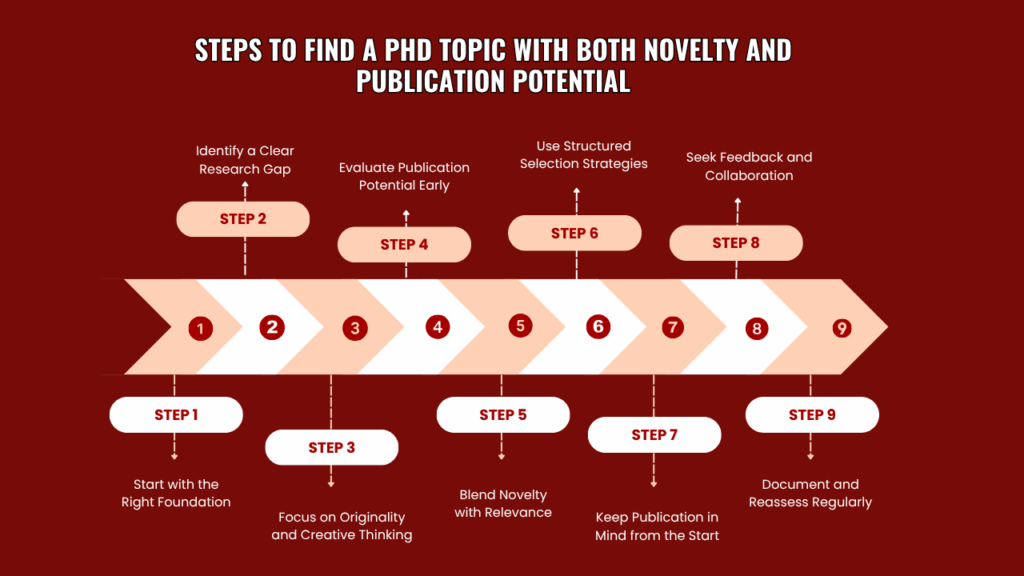How PhD Researchers Can Choose Topics with Novelty and Publishability?
Kenfra Research - Bavithra2025-10-31T17:27:28+05:30Choosing a PhD topic is not just about finding something you like. It’s about identifying a topic that is both novel and publishable. Novelty ensures your research adds something new to your field, while publishability ensures your findings are strong enough to appear in reputed journals. For PhD scholars, the challenge in PhD research topic selection is to find the right balance between creativity, academic value, and practical feasibility.
This blog explains how you can discover PhD research topic ideas that are original, meaningful, and have high publication potential.
Why Novelty and Publishability Matter for Topic Selection?
In today’s research world, originality is everything. A research topic with novelty sets you apart from other scholars, while a PhD topic with publication potential ensures your work contributes to recognized academic discussions. Journals seek research that adds fresh insights or challenges existing theories.
So, when planning your PhD, think beyond what has already been done. Ask yourself:
- What new question am I answering?
- What knowledge gap does my study fill?
- Why would others find my results valuable?
If you can confidently answer these, your work will have both novelty and publishability.
Practical Steps to Find a PhD Topic with Both Novelty and Publication Potential

Step 1: Start with the Right Foundation
Before you dive into details, clarify your field of interest. This step forms the base for PhD research topic selection. A strong foundation means your topic connects with your expertise, academic goals, and global relevance.
Read widely within your field and look for patterns or missing perspectives. This exploration phase helps you discover how to choose a PhD research topic that reflects originality and value. Remember, novelty often comes from seeing familiar things differently.
Step 2: Identify a Clear Research Gap
To build novelty, you must first spot what is missing in existing studies. This process is called research gap identification. Review recent papers, theses, and journal discussions to find areas that need more exploration.
For example:
- Are there conflicting results in previous research?
- Are certain populations or data sets underexplored?
- Is there an emerging trend that lacks solid academic work?
Knowing how to identify a research gap allows you to design your study around something truly original. Once you find that gap, your topic already has the seed of novelty.
Step 3: Focus on Originality and Creative Thinking
Originality in PhD research doesn’t always mean discovering something no one has ever thought about. It can mean taking an old idea and applying it to a new situation, or merging two known ideas into something fresh.
When developing innovative PhD research ideas, think about new methods, datasets, or perspectives you can bring in. For instance, using AI in humanities research or combining psychology with design thinking are examples of novel research ideas for PhD scholars.
This kind of cross-field creativity is often the spark that makes your work stand out — and more likely to get published.
Step 4: Evaluate Publication Potential Early
A topic can be exciting but not suitable for publication if it lacks depth, data, or relevance. To ensure your work has publication potential, analyze what top journals in your field are currently publishing.
Look for patterns:
- Do they prefer quantitative or qualitative work?
- Are they emphasizing theory-building, experiments, or case studies?
- What current debates or themes are trending in your discipline?
Aligning your topic with such trends helps you understand how to make your PhD research publishable. Journals love studies that answer timely questions and present fresh insights supported by strong evidence.
Step 5: Blend Novelty with Relevance
The most successful researchers find a middle ground between newness and need. A highly creative topic without real-world importance may not gain attention, while a common topic lacks originality.
Here’s how to strike that balance:
- Choose areas that are growing or evolving, such as climate policy, AI ethics, or sustainable design.
- Connect your research to real-world challenges while maintaining academic depth.
- Use emerging technologies or data sources that others haven’t yet applied in your field.
By doing this, you’ll create unique PhD research topics that combine innovation with clear application, a formula for publishability.
Step 6: Use Structured Selection Strategies
Having a systematic approach can make PhD research topic selection less overwhelming. Use these PhD topic selection strategies:
- Explore Interdisciplinary Areas: Many high-impact PhD research areas emerge where disciplines overlap like bioinformatics, digital education, or smart agriculture.
- Check for Data Availability: Ensure your idea can be supported with enough reliable data for publication.
- Test Your Novelty: Search for similar work in Google Scholar. If very little appears, it’s a good sign of originality.
- Refine Your Scope: A narrow, clearly defined topic is easier to manage and more likely to lead to publishable results.
Following this kind of PhD topic selection guide ensures your research stays innovative and feasible.
Step 7: Keep Publication in Mind from the Start
Many scholars wait until after finishing their thesis to think about publication. However, planning early for it can make your research stronger.
When choosing publishable PhD research topics, consider:
- Is my research problem relevant to current journal discussions?
- Will my methodology produce results that others can verify or build on?
- Does my topic have international appeal or address global issues?
By aligning your project with these questions, you increase your chances of creating best PhD research topics for publication that meet journal standards.
Step 8: Seek Feedback and Collaboration
Novelty can be subjective what seems new to you may already exist in another field. Share your ideas with mentors, supervisors, and research peers. They can help you refine how to find a unique research topic and guide you toward originality.
Sometimes, even small suggestions can turn an ordinary idea into a breakthrough one. Collaborative thinking often leads to novel research ideas for PhD scholars that are both creative and grounded.
Step 9: Document and Reassess Regularly
Once you’ve finalized your topic, document your rationale clearly, what makes it original, what gap it fills, and how it could be published. As your research progresses, revisit your idea to ensure it still holds novelty and publication value.
The world of research changes quickly, so flexibility is important. Adapting your topic slightly can help maintain how to ensure novelty in research even as new findings emerge.

Practical Tips for Success
Here are quick tips for selecting PhD topics that ensure both novelty and publishability:
- Stay updated with the latest papers in your area.
- Use citation tools like Scopus or Google Scholar to track trends.
- Attend academic conferences to learn about fresh research directions.
- Keep your topic focused but flexible.
- Always think from a publication perspective: “Would a journal find this valuable?”
By following these ideas, you’ll move closer to designing publishable PhD research topics that stand out in your discipline.
Conclusion
Creating a PhD topic with both novelty and publishability is a skill that combines curiosity, awareness, and planning. It’s not just about picking a topic; it’s about identifying a unique research question that fills a real gap and contributes to global knowledge.
By focusing on originality in PhD research, practicing thorough research gap identification, and applying smart PhD topic selection strategies, you can confidently build a study that’s innovative, impactful, and ready for publication.
From choosing the right PhD topic to ensuring 100% originality, Kenfra Research provides end-to-end academic support designed to make your research journey smoother and more successful.









